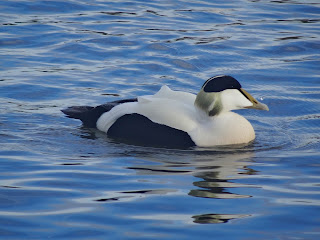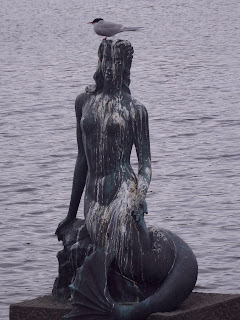Twelve more species below!
76. Icelandic chicken
Special breed of free range chicken that lay colorful eggs all year long in Reykjavik, and feed humans. They were brought to Iceland by the Vikings in the 9th century and they are rare outside of the country.
.
75. Tufted duck
Very similar to the Lesser Scaup, seen before in Ohio. It also has small differences from the Greater Scaup and Ring-necked duck. The black and white ones are the males while the females are dark brown with pale feathers. Seen in Ellidavatn and Tjorn lake, first days of June.
male and female
74. Redwing
A thrush, which -to me- is almost identical to the American Robin, except for its markings on the chest! Seen all around Reykjavik, first days of June.
carrying a meal
73. Whooped swan
Seen in lake Tjorn, June 2nd-6th.
Below you can see a -not very clear- photo of a Whimbrel (no 72). Seen near lake Ellidavatn, June 3rd.
71. Eurasian Wigeon
Only a male, seen near lake Ellidavatn, June 3rd.
70. Eurasian Oystercatcher
It can open oysters with its beak, though oysters are not a big part of its diet. Seen in BSI central station, Reykjavik, June 1st.
69. White wagtail
This small bird seen in Iceland migrates to Africa in winter. Seen in Tjorn lake and other places in the town of Reykjavik, first days of June.
68. Black-tailed Godwit
Wiki says that during breeding this bird's beak is yellow-orange on the base and dark on the tip. See pictures below. Seen near lake Ellidavatn, June 3rd.
Redwing at the back left for size comparison
67. Eurasian Golden Plover (or European Golden Plover)
Seen near lake Ellidavatn, June 3rd.
❤
66. Graylag goose
The ancestor of domesticated geese in Europe and North America. Seen all around Reykjavik, June 1st-7th.
65. Common Eider
One of the largest and most beautiful ducks in the northern hemisphere. Its feathers were used a lot for filling pillows in the past. Seen in almost every lake in Reykjavik, in Vik village, and in the harbour of Reykjavik, first days of June.
male in Tjorn lake
male Eider and Lesser Black-backed gull in Tjorn
weird neck
male and female fighting the waves
females bathing
Last but not least... I have one and only one picture of only the head of a Northern gannet (no 64 )! I hope it counts! From far away I thought it was some guillemot. Seen from a boat an hour away from the harbour of Reykjavik, June 7th.
Can you see it?
















































































